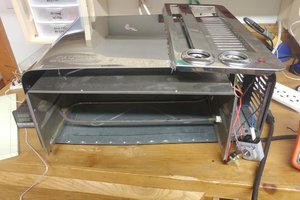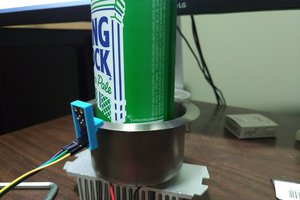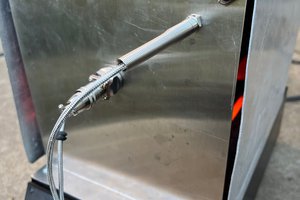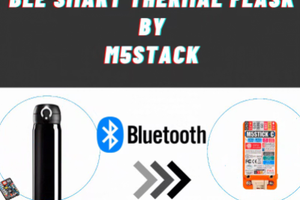Uses a thermo electric peltier module to cool or warm the user's body temperature. It's intended to be worn over major arteries and sensitive skin areas, for the best effect.
Thermoelectric Body Temperature Controller
Lower or raise your body temperature using thermometric peltier modules
 Ian Maday
Ian Maday

 skelly
skelly

 joeldarbro
joeldarbro
Sweating under things has been on my mind for a few years now. A while back, I tried to make a cooling jacket with airflow for my bike rides with my backpack. Let me rant about why thermodynamics says you should skip Peltiers and leave them to the realm of scientific curiosities and (lame) portable can-sized USB fridges.
At an optimistic 20% efficiency, if we took a 100kg person composed mainly of water and other hydrogen bonded matter, we can approximate their specific heat to water's 4kJ per kg per degree C, and take the 10W that yours is rated for (5V 2A probably), you will cool a human at 0.000005 degrees C per second, .018 degrees C per hour. By contrast, at room temperature, your body will radiate about 450W per square meter, or 0.75W on the peltier-sized area, along with a significant amount from the evaporation of your sweat. So, you're getting 2W at best, but you could have gotten a watt from the same area just by leaving it exposed. There ought to be a way to pull at least 10W from that much area if doing nothing but radiating can put out 1W.
The problem your Peltier hopes to solve (I'm guessing the equivalent of trench foot on your arm?) doesn't only have to do with temperature. We're all giant waterproof sacks surrounded by a bunch of leaking sacks of fluids (sweat glands). Dolphins don't have these glands, so they wouldn't feel as much discomfort (no excuse to strap things on dolphins). But since we're stuck with all these pockets of fluid that will spill out of us, we need a better solution, and cooling isn't enough. Remember, psychological stress can also trigger sweating. Then you'll be cold AND wet. So, if you reduce the evaporation of fluids on one area of the body, it will slowly accumulate fluids. To solve the problem, you could put a mesh on the skin, but that assumes air will get past the many layers on the outside of the watch or the general cosplay and through the mesh.
If you had infinite power (20% efficiency sucks, but even an 80% efficient heat-cycle refrigerator would need a lot of power to cool a human), Peltiers could work. You would have to do it vacuum cryopump style though, and freeze a load of the human's evaporated sweat through a foam/mesh trap pad contacting the human. Depending on your geometry, you could place bake-out heaters throughout for continuous operation. You could put it in a back-pack too, perhaps for use in a hot environment like a warzone or hike. But, nobody wants to carry an extra 15kg battery pack for the 10kW you'd need to dry out on someone's back with a cryogenic pump. Again, forget heat pumps and consider bringing the process of evaporation into the equation. There are people who cool off by using a hand dryer in their shirt, and this achieves the evaporation equation by introducing a ton of airflow.
The space shuttle missions did avoid discomfort by using a water-cooled jacket, but they had plenty of power (not portable) and enough wicking material to promote airflow on the skin. Looking into it, many people are selling water based jackets like this one, https://www.cobhammissionsystems.com/thermal-management/personal-cooling/mcs-datasheet/docview/ but at a cost of 350W which is only okay for the motorcycles and fighter jets they use them in. For looking and feeling cool at Comic-Con, you would need 250, 18650 cells for 8 hours of 350W action. That's 30 pounds of batteries. I think the better solution is something like this https://www.japantrendshop.com/kucho-airconditioned-backpack-cooling-pack-p-3931.html at any scale.
Any point on your skin that can't cool itself, whether it be an arm, back, or leg that is being excessively stressed should have an actively circulating cushion of air that it can ride on, made of a porous inflateable pad and high hydrostatic pressure fan. You could make small or large pads with small or large loads, simply by adjusting the pore geometry, pore distribution, and ribbing structure of the pads. You could also adjust the fan size, pressure, and weight while still being lighter than a heatpump based system. So, a vest made of these pads could have multiple specialized systems. For the shoulders, a low airflow, high pressure, and high load pad. It would be focused on supporting a heavy backpack without getting drenched in sweat but not cooling. For the back, a large area, low pressure, and high airflow pad on the back for cooling down the body but not supporting much of a load. The higher pressure pad does pose a risk for introducing air into the bloodstream, so, the pore distribution would need to be designed to avoid an embolism. That's not a very fun way to die compared to dying from a rollercoaster accident, so we can and must mitigate it.
My life philosophy after sitting in an expensive car with ventilated seats *once* was that being cool is not enough, and we must think outside the box by using the 2nd law of thermodynamics to generate even more cooling, simply by turning up the entropy output. That is, you've got a nearly limitless supply of condensed liquid water in your leaking sweat sacks and relatively dry air in the environment. Since the entropy of the system increases upon mixing, the reaction will occur spontaneously, but as the liquid water exits your pores, it will undergo an endothermic phase transition (still occurs spontaneously due to the increase of entropy), cooling and drying you at the same time, with far less energy input. So with this system you just need to use a fan and tubing to duct the air against the skin, and spontaneously, without very much input of energy, the air and water will mix, and the heat of the body will be transported out of the body and into the newly gaseous water molecules.
It's an especially ingenious system because the heat of vaporization characteristics of water make it so it has a higher molar enthalpy with decreased temperatures. So if you do it while cold or inactive, it's even more efficient and can run quieter with less airflow. You would apply a smaller PWM duty cycle to the cooling fan in cooler conditions. But as it gets hotter, less energy is carried in the vaporized water. This is likely because there is less hydrogen bonding at higher temperatures. So you can ramp up the PWM duty cycle of the fan and get consistent comfort.
To make this system, you just need some microcontroller, temperature sensor, high hydrostatic pressure 40mm server fan (wires are color coded for PWM, GND, and 12V signals), a 3D printed airflow manifold, and porous and flexible airflow tubes. These porous tubes would zig-zag across the areas of the cosplay you want to ventillate. It's also possible to have parallel or serial topologies for the airflow tubing, and it just depends on the project.
In a parallel configuration, from a single fan, you could also use varying lengths of porous tubes to get different airflow characteristics. One manifold can supply multiple short high pressure tubes for a high pressure shoulder area and one long tube that zig-zags and conforms across the back, leading to the same air-flow through a larger area, resulting in a lower pressure section that will better cool an actively swaying and twisting section like the lower back.
In a serial configuration, you kind of set it up like a transmission line. You expect some energy to be dissipated on the way to the main load. Similarly, along the length of a singular tube, the air slowly leaks until at the end, the pressure drops very slightly to ambient pressure to avoid the fan from running under the wrong pressure/airflow load. The tube would start at your lower back, which usually feels no load, then get to the shoulders and chest which would experience the greatest load from the backpack. When you're moving uphill, the end of the tube (your shoulders) are completely constricted and all the air flows through the pores on your lower back. When you tilt your torso as you're stepping forward, the constriction on one of the shoulders decreases and allows some air through. Each step slowly sputters air across the heavily loaded sections to keep them dry, and blows a majority of the air against the unloaded lower back to cool the body. I wish I had that when I went hiking.
I've used the 4mil LDPE tubing used for packaging small parts because you can laser weld, cut, and etch, rf weld, heat weld, or ultrasonically weld the pores and reinforcements to both generate the flat structure when inflated and the pores simultaneously. It's kind of like building upon this abandoned patent to include airflow pores on this backpack system. https://patents.google.com/patent/US20160213128A1/en
In my design for this when I was in high school, I used the wrong fan, causing my prototypes to fail. I'll be picking up this project again soon, and will share once I'm done.